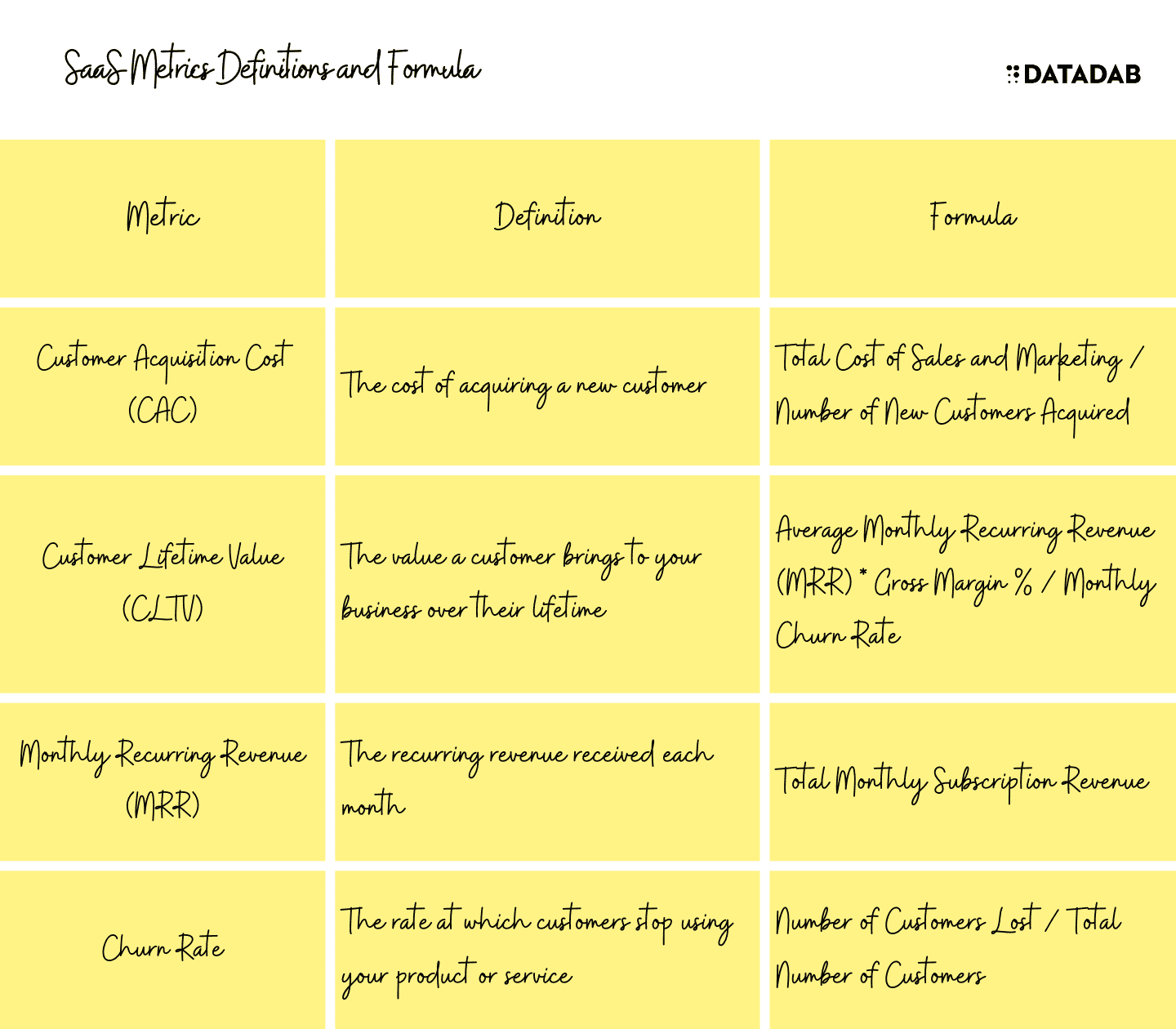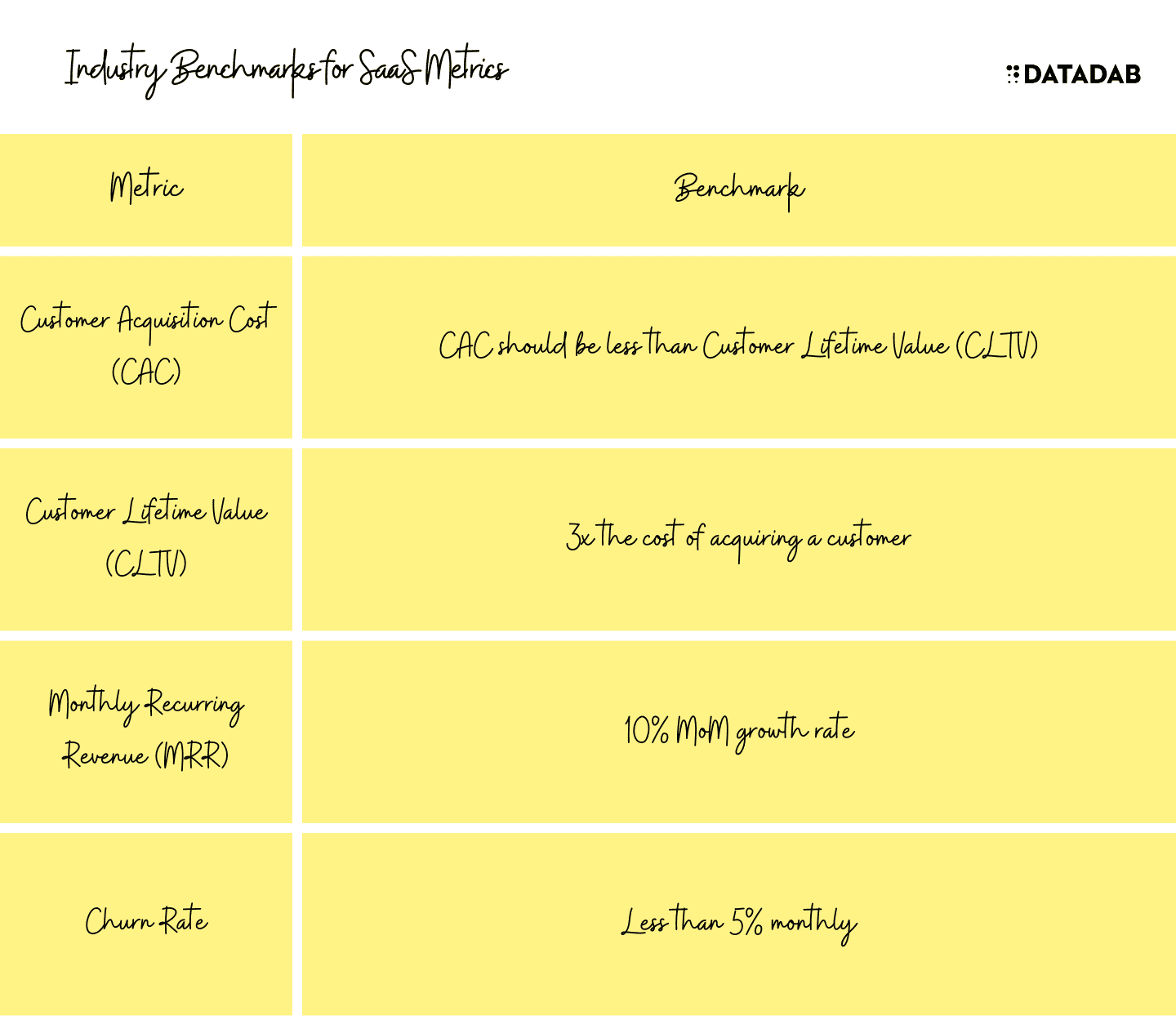Are you tired of feeling overwhelmed by the sheer number of SaaS metrics out there? Do you struggle to determine which ones actually matter for your business?
In this blog post, we're going to dive into a SaaS metrics showdown to determine which metrics are truly important for growing your business. We'll arm you with the knowledge you need to succeed and show you how to use these metrics to your advantage.


Customer Acquisition Cost (CAC)
Let's start with one of the most fundamental metrics in SaaS - customer acquisition cost (CAC). This metric measures how much it costs to acquire a new customer. It's calculated by dividing the total cost of sales and marketing by the number of new customers acquired during a specific period.
Why it matters: CAC is a key indicator of how efficient your sales and marketing efforts are. A high CAC means that you're spending too much to acquire new customers, which can impact your profitability. Conversely, a low CAC means that you're acquiring new customers at a lower cost, which can lead to higher profits.
Imagine you're running a restaurant, and you've decided to invest in a new advertising campaign to attract more customers. You've spent a lot of money on flyers, posters, and digital ads, but you do not see the results you expected. After calculating your CAC, you realize that you're spending more money to acquire new customers than they're actually spending at your restaurant. In this scenario, you would need to reevaluate your advertising strategy and find ways to reduce your CAC to achieve profitability.
How to improve it: There are several ways to reduce your CAC, including:
- Improving your website's conversion rate
- Focusing on high-quality leads
- Utilizing more cost-effective marketing channels
- Optimizing your sales process

Customer Lifetime Value (CLV)
Next up is the customer lifetime value (CLV), which measures the total amount of revenue that a customer is expected to generate for your business during their lifetime. It's calculated by multiplying the average revenue per customer by the average customer lifespan.
Why it matters: CLV is a crucial metric for SaaS businesses because it helps you understand how much a customer is worth to your business over time. This information can help you make important decisions about how much you're willing to spend to acquire new customers and how much you're willing to invest in retaining existing customers.
Imagine you're running a subscription-based service and you've noticed that many of your customers are canceling their subscriptions after just a few months. By calculating your CLV, you realize that your customers aren't generating as much revenue as you initially thought. To increase your CLV, you may need to focus on improving your customer retention rates, offering incentives for customers to upgrade to higher-priced plans, or developing a customer loyalty program.
How to improve it: There are several ways to increase your CLV, including:
- Offering upsells and cross-sells to existing customers
- Improving your customer retention rates
- Increasing the average revenue per customer
- Developing a customer loyalty program
Monthly Recurring Revenue (MRR)
Monthly recurring revenue (MRR) measures the predictable monthly revenue generated by your customers' subscription payments. It's calculated by multiplying the number of paying customers by the average revenue per customer per month.
Why it matters: MRR is a key metric for SaaS businesses because it provides a clear picture of the company's revenue trajectory. Tracking MRR over time allows you to identify growth patterns, potential churn, and opportunities for upselling or cross-selling.
Imagine you're running a software company that offers your customers a range of pricing plans. By analyzing your MRR, you realize that a significant percentage of your revenue comes from a handful of high-paying customers. While this may be a positive in the short term, it could also indicate a lack of diversity in your customer base. By developing pricing plans and features that cater to a wider audience, you can increase your MRR and ensure a more stable revenue stream.
How to improve it: There are several ways to increase your MRR, including:
- Upselling or cross-selling additional features or services to existing customers
- Offering pricing plans that encourage customers to upgrade to higher-priced tiers
- Focusing on customer retention to reduce churn and maintain a predictable revenue stream
Remember that metrics aren't just numbers on a page - they tell a story about your business and can help you make informed decisions about how to grow and improve. We hope this SaaS metrics showdown has helped you better understand the importance of these metrics and how to use them to drive success for your business.
FAQ
What is CAC, and why is it important for my SaaS business?
Customer Acquisition Cost (CAC) is the cost of acquiring a new customer. It's calculated by dividing your total sales and marketing costs by the number of new customers acquired during a specific period. CAC is important for your SaaS business because it can help you understand the cost-effectiveness of your marketing campaigns and inform decisions about where to allocate your resources. Reducing your CAC can improve your profitability and scale your business more efficiently.
How do I calculate CLV, and why is it important for my SaaS business?
Customer Lifetime Value (CLV) is the total value that a customer is expected to bring to your business over their lifetime. It's calculated by multiplying the average purchase value by the average number of purchases per customer per year and then multiplying that by the average customer lifespan. CLV is important for your SaaS business because it can help you understand the long-term value of your customers and inform decisions about pricing, marketing, and customer support.
What is churn, and how can I reduce it in my SaaS business?
Churn is the percentage of customers who cancel their subscription or stop using your product or service during a specific period. To reduce churn in your SaaS business, understand why customers are leaving and take steps to address those issues. This could involve improving your product or service, providing better support, or adjusting your pricing. Staying in touch with your customers and offering incentives for loyalty can also help reduce churn.
What are gross margins, and how can I improve them in my SaaS business?
Gross margins are the difference between your revenue and the cost of goods sold. In a SaaS business, this typically includes the cost of hosting and delivering your product or service. To improve gross margins in your SaaS business, you can focus on reducing costs and increasing efficiency. This could involve streamlining your operations, investing in automation, or negotiating better deals with your vendors. You can also focus on selling more high-margin products or services.
What is MRR, and how can I increase it in my SaaS business?
Monthly Recurring Revenue (MRR) is the predictable monthly revenue generated by your customers' subscription payments. To increase MRR in your SaaS business, you can focus on upselling or cross-selling additional features or services to existing customers, offering pricing plans that encourage customers to upgrade to higher-priced tiers, and focusing on customer retention to reduce churn and maintaining a predictable revenue stream.
Which SaaS metrics should I focus on as a startup?
Focus on metrics that are directly related to your growth and sustainability. CAC, CLV, and churn are all critical metrics to track, as they can help you understand the cost-effectiveness of your marketing campaigns, the long-term value of your customers, and the health of your customer base. MRR is also an essential metric for startups, as it can provide a clear picture of your revenue trajectory and growth potential.
How often should I track my SaaS metrics?
Track your SaaS metrics regularly, ideally on a monthly basis. This can help you identify trends and patterns over time and make informed decisions about how to improve your business. Keep track of your metrics consistently using a reliable tracking system that integrates with your other business tools.
What are some common mistakes to avoid when tracking SaaS metrics?
One common mistake to avoid is relying too heavily on vanity metrics that don't actually provide meaningful insights into your business. Metrics like website traffic or social media followers can be useful indicators of brand awareness, but they don't necessarily translate to revenue or customer growth. Avoid tracking too many metrics at once, as this can be overwhelming and make it difficult to focus on the most important areas of your business.
How can I use SaaS metrics to inform my marketing strategy?
SaaS metrics can provide valuable insights into your customers' behavior and preferences, which can, in turn inform your marketing strategy. For example, if you notice a high churn rate among customers who sign up for a free trial but don't convert to paid subscriptions, you may want to focus your marketing efforts on encouraging these customers to upgrade. Alternatively, if you notice that customers who purchase a certain feature or plan have a higher CLV, you may want to focus on marketing these higher-margin offerings to new and existing customers.
What should I do if my SaaS metrics are not where I want them to be?
If your SaaS metrics are not meeting your expectations, take a data-driven approach to identify the root causes of the problem. This could involve conducting customer surveys, analyzing user behavior data, or experimenting with different pricing or marketing strategies. Set realistic goals and benchmarks for your metrics and track your progress over time so that you can adjust your approach as needed and continue to improve your business.







